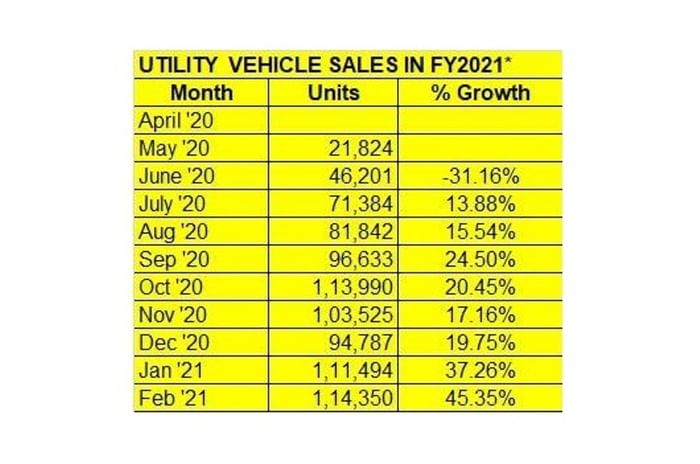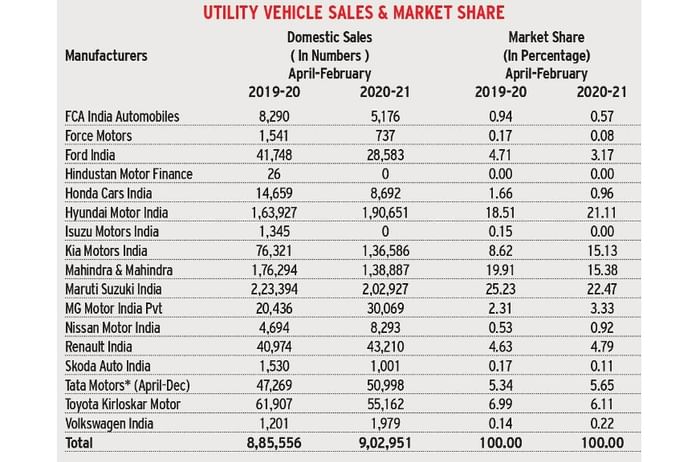Apex industry body SIAM recently released the wholesale vehicle numbers for the Indian automotive industry for February 2021, and cumulative data for the April 2020-February 2021 period. The data shows that the UV segment is going strong in an otherwise troubled market.
- SUV, MPV sales grow while rest of the industry sees a year-on-year decline
- FY2021 UV sales (till February) stand at 9,02,951 units
- Maruti is the leader in the UV segment, followed by Hyundai, Mahindra, Kia and Tata
While the passenger vehicle (PV) industry is not out of the woods yet, with sales of 23,35,808 units (-10.35 percent) in the 11-month period – with passenger car sales at 13,36,473 units (-16.20 percent) and vans at 96,384 units (-23 percent) – it is the utility vehicle (UV) segment that is packing all the punches. At 9,02,951 units (+1.96 percent), it is the sole sub-segment in the April 2020-February 2021 period to be in positive territory amongst PVs, three-wheelers and two-wheelers.
Annual UV sales set to cross the one million mark this fiscal
Check out the monthly stats below for the ongoing fiscal year and it’s amply clear that the UV segment, which includes SUVs and MPVs, is firing on all cylinders. Sales crossed the 1,00,000 unit mark in October and November 2020, January and February 2021, and came close to that figure in two other months. What’s more, there was a decent run in the early months of the COVID-19-impacted year, the washout month of April 2020 notwithstanding.

Given that UV sales in the first 11 months of FY2021 in the domestic market are logged at 9,02,951 units (add Tata Motors’ 22,334 units for January and February 2021), it can be forecast that UV sales for FY2021 will easily cross the 10,00,000 or one-million mark for the first time ever.
The closest the Indian auto industry came to hitting the million-unit mark in UV sales was in FY2020, when at 9,46,010 units it fell short of the milestone by 53,990 units. Total UV sales in FY2019 were 9,41,461 units.
Some number-crunching reveals that cumulative 15-year UV sales in India have crossed the 8.3 million mark, speedy growth coming from FY2013 when UV sales crossed the half-a-million unit mark for the first time. Nearly 9 million UVs have been sold in the past nine fiscal years (see data table below).

How do the individual automakers stack up?
In a vehicle segment where sales are booming, rivalry can only be intense, which is amply seen in the UV market share statistics for the April 2020-February 2021 period (see detailed table below).
PV market leader Maruti Suzuki India is also the UV market leader with 2,02,927 units and a 22.47 percent market share. What is creditable is that, despite diving out of the diesel engine market in the past year, the company is just 9.16 percent behind its year-ago sales of 2,23,394 units.
Meanwhile, a hard-charging Hyundai Motor India with 1,90,651 units (up 16.30 percent YoY) is close behind with a 21.11 percent share, up from 18.51 percent a year ago. Credit a lot of that seedy growth to the surging demand for India’s bestselling UV – the new Creta.

Mahindra & Mahindra, at No. 3 position, has 1,38,887 units to its name and a UV market share of 15.38 percent, down from 19 percent a year ago, but the new Thar is giving it new market traction.
Kia Motors India, with 1,36,586 units and 15.13 percent, is in fourth position – a remarkable achievement having launched its first product — the Seltos — barely 18 months ago. A resurgent Tata Motors is at No. 5 position.
Things turn interesting when Hyundai and Kia sales and market share are clubbed together. With a total of 3,27,237 units, the two Korean manufacturers have the majority UV market share of 36.24 percent.
SUVs: the cars for all reasons and all seasons
The all-encompassing appeal of the SUV is not difficult to fathom. Bigger and taller than regular cars, they give the driver a better view of the road ahead – so important in a country like India. And the raised ground clearance is always helpful when it comes to driving over rugged terrain.
Furthermore, being larger than hatchbacks and some sedans, they also pack ample storage space, have cavernous boots and plenty of room at the rear to stretch out – just right to be used as a family car. But big can also be small, because with the advent of the sub-four-metre compact SUV category in India, SUVs can easily manoeuvre through dense traffic and also fit into tight spots, armed as they are these days with driving aids.
Tanking up is also not a hugely expensive affair as it used to be with SUVs in the past. Manufacturers and engine engineering have made huge advances over the years, which is why SUVs in recent years are both fuel efficient and also more eco-friendly.
Of course, when it comes to ride and handling, SUVs are the vehicle you’d like to have when you are driving in bad weather conditions or unknown roads. Sizeable weight, bigger and wider wheels and robust nature ensure they deliver improved grip and stability. Safety is paramount and today most SUVs come with ABS, EBD, ESP and even hill-hold and hill-descent control in some cases.
Growth outlook: SUV-ival of the fittest
Moreover, in India, demand for sub-four-metre compact SUVs seems insatiable and manufacturers are going all out to introduce new products. The coming months will see a number of new models getting introduced, including the likes of the new Mahindra XUV500, Skoda Kushaq, Volkswagen Taigun and the Citroen C5 Aircross.
Clearly, there's plenty of action coming up on the UV front in 2021. Stay tuned to more number-crunching coming your way.
Also see:
Car, SUV sales up 23 percent in February 2021
February 2021: Car, SUV sales up as overall vehicle registrations decline



Comments
Member Login
Personal Details
No comments yet. Be the first to comment.